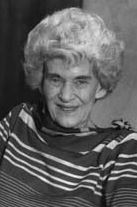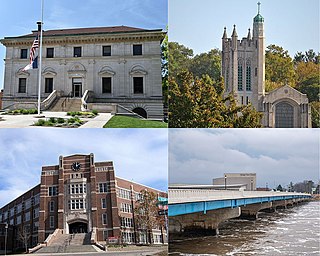
Ottumwa is a city in and the county seat of Wapello County, Iowa, United States. The population was 25,529 at the time of the 2020 U.S. Census. Located in the state's southeastern section, the city is split into northern and southern halves by the Des Moines River.
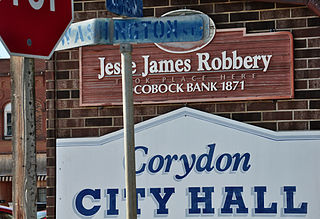
Corydon is a city in Wayne County, Iowa, United States. The population was 1,526 in the 2020 census, a decline from 1,591 in 2000. It is the county seat of Wayne County.

KYOU-TV is a television station licensed to Ottumwa, Iowa, United States, serving Ottumwa and Kirksville, Missouri, as an affiliate of Fox, NBC and The CW Plus. The station is owned by Gray Television and maintains studios on West 2nd Street in Downtown Ottumwa; its transmitter is located one mile (1.6 km) east of Richland, Iowa. A translator, K30MG-D, offers additional coverage in the Kirksville area.

The 1960 Iowa Hawkeyes football team represented the University of Iowa in the 1960 Big Ten Conference football season. The Hawkeyes were led by head coach Forest Evashevski, coaching in his 9th season. Iowa finished as co-Big Ten Conference champions with the Golden Gophers. The Golden Gophers were selected to represent the Big Ten in the Rose Bowl. The Hawkeyes' nine-game schedule was made up of eight ranked opponents and unranked Notre Dame.

Lucile Esma Lundquist Blanch was an American artist, art educator, and Guggenheim Fellow. She was noted for the murals she created for the U.S. Treasury Department's Section of Fine Arts during the Great Depression.

Elizabeth E. Terrell was an American artist who completed works for the Works Progress Administration. Born in Toledo, Ohio, Terrell is known for her abstract and modern figures, still life paintings, and murals. She exhibited her art at the Art Institute of Chicago, Brooklyn Museum of Art, Metropolitan Museum of Art, Museum of Modern Art, New York, Pennsylvania Academy of Fine Arts and Whitney Museum of American Art. She did frescos, mixed media, mosaics, gouache and oil paintings. She produced a mural at the Starke, Florida Post Office titled "Reforestation" (1942). She was part of an exhibition with Rufino Tamayo and Julian Levi at the Ottumwa Art Center in Ottumwa, Iowa. Her work is in the collection of the Smithsonian American Art Museum.

U.S. Highway 34 (US 34) is a United States Highway that runs across the southern third of Iowa. It begins on a bridge over the Missouri River west of Glenwood and travels east where it meets Interstate 29 (I-29) and US 275. Through southwestern Iowa, the highway is, for the most part, a two-lane rural road with at-grade intersections; there are interchanges with US 59 near Emerson and US 71 near Stanton and Villisca. At Osceola, the highway intersects I-35 and US 69. Just east of Ottumwa, where the road meets US 63, the road joins the four-lane Iowa 163 for the remainder of its trek through the state. At Mount Pleasant, it overlaps US 218 and Iowa 27, the Avenue of the Saints Highway. From there, the road heads to the southeast where it crosses the Mississippi River on the Great River Bridge at Burlington.
Beulah Ruth Bettersworth (1894–1968) was an artist and muralist in the early 20th century. She was most known for her still lifes and street scenes. Her painting Christopher Street, Greenwich Village was selected for the White House by President Franklin Roosevelt and is now in the permanent collection of the Smithsonian American Art Museum. She won national competitions to complete post office murals for the post offices in Indianola and Columbus, Mississippi.
Olga Mohr (1905–1955) was an American artist who worked in various mediums including painting, ceramics and weaving. She was one of the WPA′s Section of Fine Arts artists and created the post office mural for Stilwell, Oklahoma. She was also in charge of the Federal Art Project for the Cincinnati public schools and was the only female member of the New Group of Cincinnati Artists, who studied and exhibited modern art in Ohio during the decade preceding World War II.

Verona Burkhard (1910–2004) was an American artist, known for her murals painted for the U.S. Treasury Department. She participated in four public projects including three United States post office murals and five murals completed for the Immigration and Naturalization Service. She has works in the permanent collections of the Smithsonian American Art Museum and the Western Colorado Center for the Arts. As of 2015, her murals completed for the post offices of Powell, Wyoming; Deer Lodge, Montana; and Kings Mountain, North Carolina are still hanging in the buildings which were the original post offices. In addition to her public artworks, Burkhard received the 1943 Alger Award from the National Association of Women Artists and was one of the first honorees of the "Colorado Women of Achievement" program in 1966.
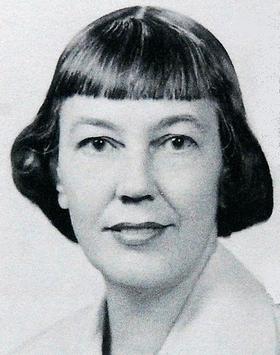
Tracy Montminy, who completed early works as Elizabeth Tracy, (1911–1992) was an American artist and muralist. During the WPA's era, she painted murals in civic buildings, including murals in the library in Cambridge, Massachusetts; the fire and police building of Saugus, Massachusetts; the Milton, Massachusetts, post office; Medford, Massachusetts City Hall; the post office of Downers Grove, Illinois; and the post office in Kennebunkport, Maine, as well as others both in the U.S. and abroad. She was an art instructor at the University of Missouri and the American University of Beirut, continuing her own painting projects simultaneously with her teaching into the 1980s. Upon her death, she established a trust to create the Montminy Art Gallery in Columbia, Missouri.
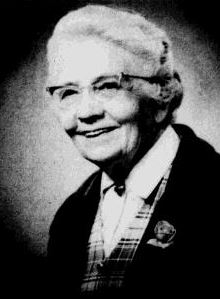
Kady Faulkner (1901–1977) was an American muralist, painter and art instructor who gained recognition in the middle of the 20th century. She has works in the permanent collections of the Smithsonian American Art Museum, the Pennsylvania Academy of the Fine Arts, and the Great Plains Art Museum, as well as others. She was selected to work on the United States post office murals project of the U.S. Treasury during the New Deal and completed a mural for the Valentine, Nebraska post office. A mosaic by Faulkner in Kenosha, Wisconsin adorns the former bakery on the Kemper Hall grounds. She was an associate professor of Art at the University of Nebraska–Lincoln between 1930 and 1950 and then instructed headed the Art Department at Kemper Hall until her retirement.

Miriam Ibling was an American muralist who worked on art projects for the New Deal's Section of Painting and Sculpture creating public art in Minnesota. Her lithograph Sheep Resting is in the collection of the National Gallery of Art in Washington, D.C.
Fay Elizabeth Davis was an American artist, graphic designer and muralist who created three post office murals as part of the art projects for the New Deal's Section of Painting and Sculpture.

Caroline Speare Rohland was an American artist and muralist who created three post office murals, as part of the art projects for the New Deal's Section of Painting and Sculpture. In addition to the three murals, Rohland has works in the permanent collections of the Library of Congress, The Honolulu Academy of Art, the New Mexico Museum of Art and the Whitney Museum of American Art.
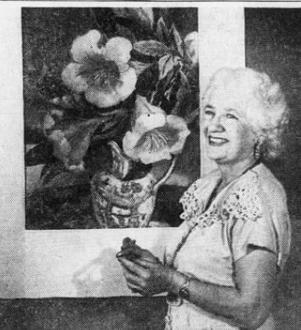
Mildred W. Pelzer was an American art teacher, artist and muralist known for her work in public spaces. In addition to the mural for the post office mural project in Waverly, Iowa, she completed eight murals for the Hotel Jefferson, of Iowa City and a mural for the lobby of the Press-Citizen. In addition to her mural work, Pelzer was known for portraits, floral works and landscapes.

Marjorie Schick was an innovative American jewelry artist and academic who taught art for 50 years. Approaching sculptural creations, her avant-garde pieces have been widely collected. Her works form part of the permanent collections of many of the world's leading art museums, including the Hermitage Museum in Saint Petersburg, Russia; the Museum of Arts and Design in New York City; the National Museum of Modern Art in Kyoto, Japan; the Philadelphia Museum of Art in Pennsylvania; and the Victoria and Albert Museum of London.
Mattie Harper was an American politician who served in the Iowa House of Representatives from the 90th district from 1973 to 1977.

U.S. Highway 63 (US 63) is a United States Highway that runs through the eastern third of Iowa. It begins at the Missouri state line southwest of Bloomfield and travels north through Ottumwa, Oskaloosa, Tama, Waterloo, and New Hampton. It ends at the Minnesota state line at Chester. Between Ottumwa and Oskaloosa, the highway is a four-lane controlled-access highway. Through Waterloo and New Hampton, it is partially controlled; that is, the road as both grade-separated interchanges and at-grade intersections. The rest of the highway is largely a two-lane rural highway.
Yampa is a small unincorporated community in Wapello County, Iowa, United States.
